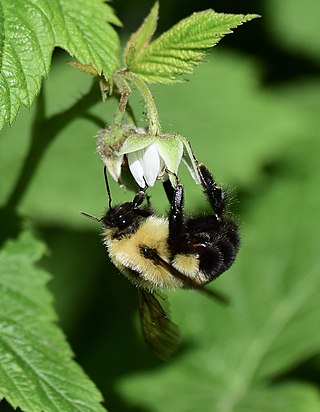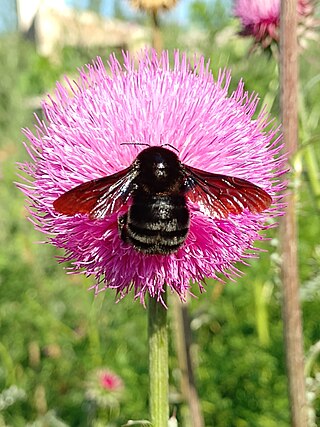
A bumblebee is any of over 250 species in the genus Bombus, part of Apidae, one of the bee families. This genus is the only extant group in the tribe Bombini, though a few extinct related genera are known from fossils. They are found primarily in higher altitudes or latitudes in the Northern Hemisphere, although they are also found in South America, where a few lowland tropical species have been identified. European bumblebees have also been introduced to New Zealand and Tasmania. Female bumblebees can sting repeatedly, but generally ignore humans and other animals.

Bombus terrestris, the buff-tailed bumblebee or large earth bumblebee, is one of the most numerous bumblebee species in Europe. It is one of the main species used in greenhouse pollination, and so can be found in many countries and areas where it is not native, such as Tasmania. Moreover, it is a eusocial insect with an overlap of generations, a division of labour, and cooperative brood care. The queen is monandrous which means she mates with only one male. B. terrestris workers learn flower colours and forage efficiently.

The early bumblebee or early-nesting bumblebee is a small bumblebee with a wide distribution in most of Europe and parts of Asia. It is very commonly found in the UK and emerges to begin its colony cycle as soon as February which is earlier than most other species, hence its common name. There is even some evidence that the early bumblebee may be able to go through two colony cycles in a year. Like other bumblebees, Bombus pratorum lives in colonies with queen and worker castes. Bombus pratorum queens use aggressive behavior rather than pheromones to maintain dominance over the workers.

Bombus lapidarius is a species of bumblebee in the subgenus Melanobombus. Commonly known as the red-tailed bumblebee, B. lapidarius can be found throughout much of Central Europe. Known for its distinctive black and red body, this social bee is important in pollination.
Bombus polaris is a common Arctic bumblebee species. B. polaris is one of two bumblebees that live above the Arctic Circle. The other is its social parasite Bombus hyperboreus. B. polaris is a social bee that can survive at near freezing temperatures. It has developed multiple adaptations to live in such cold temperatures. B. polaris has a thicker coat of hair than most bees, utilizes thermoregulation, and makes insulated nests.

Bombus sylvestris, known as the forest cuckoo bumblebee or four-coloured cuckoo bee, is a species of cuckoo bumblebee, found in most of Europe and Russia. Its main hosts are Bombus pratorum, Bombus jonellus, and Bombus monticola. As a cuckoo bumblebee, Bombus sylvestris lays its eggs in another bumblebee's nest. This type of bee leaves their young to the workers of another nest for rearing, allowing cuckoo bumblebees to invest minimal energy and resources in their young while still keeping the survival of their young intact.

Bombus pensylvanicus, the American bumblebee, is a threatened species of bumblebee native to North America. It occurs in eastern Canada, throughout much of the Eastern United States, and much of Mexico.

The two-spotted bumble bee is a species of social bumble bee found in the eastern half of the United States and the adjacent south-eastern part of Canada. In older literature this bee is often referred to as Bremus bimaculatus, Bremus being a synonym for Bombus. The bee's common name comes from the two yellow spots on its abdomen. Unlike many of the other species of bee in the genus Bombus,B. bimaculatus is not on the decline, but instead is very stable. They are abundant pollinators that forage at a variety of plants.

Bombus vosnesenskii, the yellow-faced bumblebee, is a species of bumblebee native to the west coast of North America, where it is distributed from British Columbia to Baja California. It is the most abundant species of bee in this range, and can be found in both urban and agricultural areas. Additionally, B. vosnesenskii is utilized as an important pollinator in commercial agriculture, especially for greenhouse tomatoes. Though the species is not currently experiencing population decline, urbanization has affected its nesting densities, and early emergence of the B. vosnesenskii has been implicated in the increasing lack of bee diversity on the West coast.

Bombus occidentalis, the western bumblebee, is one of around 30 bumblebee species present in the western United States and western Canada. A recent review of all of its close relatives worldwide appears to have confirmed its status as a separate species.

Bombus fervidus, the golden northern bumble bee or yellow bumblebee, is a species of bumblebee native to North America. It has a yellow-colored abdomen and thorax. Its range includes the North American continent, excluding much of the southern United States, Alaska, and the northern parts of Canada. It is common in cities and farmland, with populations concentrated in the Northeastern part of the United States. It is similar in color and range to its sibling species, Bombus californicus, though sometimes also confused with the American bumblebee or black and gold bumblebee. It has complex behavioral traits, which includes a coordinated nest defense to ward off predators. B. fervidus is an important pollinator, so recent population decline is a particular concern.

Bombus impatiens, the common eastern bumble bee, is the most commonly encountered bumblebee across much of eastern North America. They can be found in the Eastern temperate forest region of the eastern United States, southern Canada, and the eastern Great Plains. Because of their great adaptability, they can live in country, suburbs, and even urban cities. This adaptability makes them a great pollinator species, leading to an increase in their commercial use by the greenhouse industry. This increase consequently led to their farther spread outside their previous distribution range. They are considered one of the most important species of pollinator bees in North America.

Bombus frigidus, the frigid bumblebee, is a rare species of bumblebee largely found in Canada and parts of the United States.

Bombus affinis, commonly known as the rusty patched bumble bee, is a species of bumblebee endemic to North America. Its historical range in North America has been throughout the east and upper Midwest of the United States, north to Ontario, Canada, where it is considered a "species at risk", east to Quebec, south to Georgia, and west to the Dakotas. Its numbers have declined in 87% of its historical habitat range. On January 10, 2017, the United States Fish and Wildlife Service placed B. affinis on the list of endangered species, making the rusty patched bumblebee the first bee to be added to the list in the continental United States.

Bombus terricola, the yellow-banded bumblebee, is a species of bee in the genus Bombus. It is native to southern Canada and the east and midwest of the United States. It possesses complex behavioral traits, such as the ability to adapt to a queenless nest, choose which flower to visit, and regulate its temperature to fly during cold weather. It was at one time a common species, but has declined in numbers since the late 1990s, likely due to urban development and parasite infection. It is a good pollinator of wild flowers and crops such as alfalfa, potatoes, raspberries, and cranberries.

Bombus pauloensis is a neotropical bumblebee, formerly known as Bombus atratus, that is found throughout regions of South America, including Colombia, Ecuador, Brazil, and Argentina. It lives in social colonies that include a founder queen/queens, workers and brood. B. pauloensis is somewhat unusual because of its potential to oscillate between polygynous and monogynous nesting cycles. Bombus pauloensis was the first species in the genus Bombus that was discovered to display such polygynous nesting patterns. The polygynous nesting cycles lead to certain specific types of behavior including queen-queen aggression. Nests can also be perennial, which is a characteristic rarely found in other bumblebees. B. pauloensis can be helpful to agricultural because of their ability to pollinate different species of plants. B. pauloensis has been found to occupy a range of geographic areas and climates throughout South America. Colonies have the ability to thermoregulate nests and keep them a little bit warmer than the outside environment. Foraging workers use muscle contractions to maintain stable temperatures and coupe with seasonal and daily fluctuations in temperature.

Bombus morio is one of the few bumblebee species found in South America. These bees reside mainly in the forests of Brazil, nesting on the surface of the ground. They are one of the biggest species of bumblebee and are important pollinators. They are one of the few species of bees that exhibit buzz pollination to collect pollen from the flowers.

Bombus vancouverensis is a common species of eusocial bumblebee of the subgenus Pyrobombus. B. vancouverensis inhabits mountainous regions of western North America, where it has long been considered as a synonym of Bombus bifarius, and essentially all of the literature on bifarius refers instead to vancouverensis. B. vancouverensis has been identified as one of the two species of bumblebee observed to use pheromones in kin recognition. The other is the frigid bumblebee, Bombus frigidus.
Bombus lantschouensis is one of many bumblebee species native to China. Like all bumblebee species, they are characterized by their round bodies that are larger than honeybees. They have diverse color patterns. but are known for their eye-catching black and yellow coloring. They are also known for their furry-like appearance due to their body being covered in soft hair which are long branched setae. This hair is referred to as pile.




















